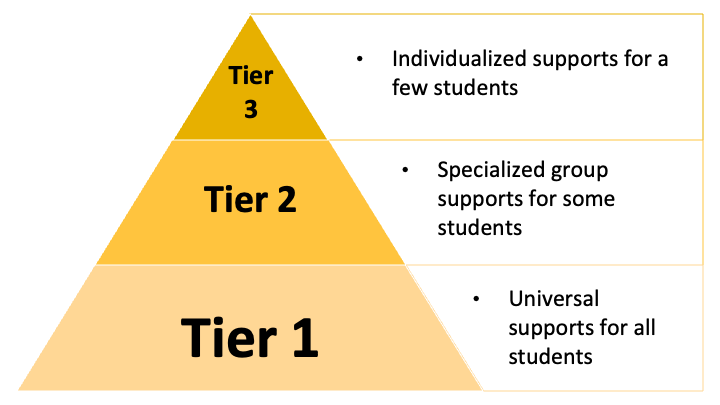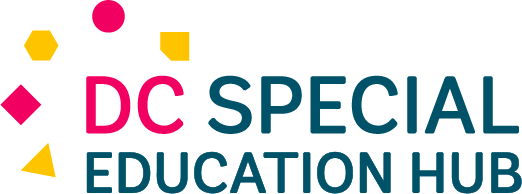 Learning Strategies
Learning Strategies
Every special education student has their own unique set of strengths and areas for growth. While there is no “one size fits all” support, the following strategies can help students across a variety of disability categories with tasks at school and beyond.”
Executive Functioning Strategies
Executive functioning encompasses the skills needed to plan, manage, and complete tasks. This includes “soft skills” like working memory, time management, organization, flexible thinking, initiating tasks, self-monitoring, and impulse control.
Children who struggle with executive functioning may:
- Have trouble managing their time
- Struggle to organize their thoughts and ideas
- Often lose or misplace belongings
- Forget what they just read or heard
- Have trouble prioritizing or envisioning tasks
- Fixate on a certain topic, idea, or feeling
- Get “stuck” when given multi-step directions
Executive functioning expectations and gaps look different as students age. For example, a kindergartener may throw tantrums over minor things, while a high schooler may have trouble participating in group projects.
Regardless of where a child starts, they can always improve executive functioning skills through practice and the use of the following strategies.
Visual or Written Schedules: Many children with executive functioning difficulties may have challenges with staying on task, managing their time, or envisioning multi-step processes. Keeping a schedule can help these children stay organized. While digital calendars or day planners may help older children, creating a daily picture schedule can help younger children.
Stick to Consistent Routines: Keeping consistent routines can help children anticipate tasks and hone time management. Sticking to the same morning and evening routine can also help develop good habits and independence.
Break Down Directions: Kids who struggle with executive functioning often have trouble remembering and executing multi-step directions. Breaking tasks down one step at a time can support their confidence and completion. For example, instead of telling a child, “Go get the cleaning supplies out of the closet, mop the floor, and wipe down the counter,” try breaking it down one step at a time. Providing visual or written directions (like a list of chores or illustrations of a task for young children) is also useful. When it comes to academics, giving one step at a time or providing visual directions (like the written steps of a math formula) can help with task completion and skill retention.
Model Tasks: Explicitly modeling tasks at home and school can support children in conceptualizing new tasks. Verbally narrating each step (“First, I open the jar. Then, I use the knife to spread the peanut butter.”) can also help kids identify and practice multi-step processes.
Practice Flexible Thinking: Many games, jokes, and wordplay can support children in developing flexible thinking skills. Strategy games like Blokus or Connect Four and logic puzzles like Sudoku can help kids consider multiple outcomes and practice changing their approach when needed. Puns, jokes (“What did the ocean say to the pirate? Nothing, it just waved.”), and books like Amelia Bedelia can show kids that words can have more than one meaning. Encourage children to think up their own punny jokes and double-meanings!
Reading Strategies
Many children with disabilities may need additional supports in reading. Students across many disability categories can struggle with decoding, comprehension, and reading stamina. The strategies below can support these children at school and at home.
Partner Reading: Reading with a family member, teacher, or peer can support students in a number of ways. Partner reading models strong fluency for struggling readers and helps to fill comprehension gaps. It also “chunks” the text into more manageable sections and makes reading a social activity. Seeing family members and teachers excited about reading can also encourage positive reading habits.
“Chunked” Texts: Long texts can often be daunting and difficult for struggling readers to access. Breaking up these texts into “chunks” either verbally (“Just read paragraphs 1-3,”) or visually (by inserting pictures or extra blank space) can help children focus their attention and make long texts more approachable.
Independent Reading of “Just Right” Texts: The best way to become a better reader is by reading. Kids independently reading books at or just above their reading level supports vocabulary acquisition, comprehension, fluency, and more. To build stamina, try “Drop Everything and Read” times starting at just 5-10 minutes of silent, sustained reading. Then, increase the time bit by bit each time.
Attach Images or Actions to Sight Words: Classic strategies like “sound it out” don’t always work for sight words, which often have nonstandard spelling or pronunciation. Helping children associate sight words with images or hand motions can support memory of meaning and pronunciation.
Ask Your Child Questions About Their Reading: Support comprehension by asking your child about the book or article they are reading. Some good starter questions include:
- Who is the main character? How would you describe them?
- What happened first? What happened next?
- Who is your favorite character? Why?
- What do you think will happen next? Why?
- What kinds of lessons do you think the author wants you to learn?
- How does this picture/graph/chart/etc. help you better understand the text?
Additional Resources:
Math Strategies
Many children with disabilities may need additional supports in math. Students across many disability categories can struggle with math facts, multi-step equations, word problems, and more. The strategies below can support these children at school and at home.
Step-by-Step Directions: As students become older, most math problems become multi-step. Providing written step-by-step directions for the relevant formula or process can help students improve their understanding and self-monitor. It can also help parents and teachers in identifying exactly where the child’s understanding is breaking down. Visual models and solved sample problems can also support students in the same way.
Using Manipulatives: Using beads, blocks, number lines, and more can help students better conceptualize mathematical concepts. For younger kids, using manipulatives related to their interests (“How many dinosaurs are there?”) can also boost engagement.
Annotating Word Problems: Often, students with disabilities struggle with word problems because they require multi-step thinking and blend skills from multiple subject areas. Teaching students to underline or highlight key words can support them in breaking down these problems. Practicing which words go with which operations (for example, “how many all together,” indicates an addition problem) can also build children’s word problem skills and confidence.
Math Games: Math lends itself well to a number of different games! Engage kids in learning math facts and counting by playing board games, card games, math puzzles, or online math games. Math can also be found in many different interests like sports and music.
Writing Strategies
Many children with disabilities may need additional supports in writing. Students across many disability categories can struggle with writing mechanics, grammar, spelling, and structure. The strategies below can support these children at school and at home.
Encourage Reading: One of the best ways for children to become better writers is to become better readers. Reading often and widely helps kids build their vocabulary, spelling, and knowledge of structure.
Use Story Starters: Staring at a blank page can be daunting for anyone. Providing a topic, illustration, or the first part of a story can support children in getting their creative juices flowing. You can also try writing together by alternating writing sentences or coming up with ideas together.
Use Speech-to-Text: Often, children with disabilities can talk out what they want to say much faster than they can express themselves in writing. For these children, having a scribe or speech-to-text program can help them minimize this frustration and get their initial ideas out. Once their ideas are out, kids can use their draft to examine how they structure their ideas and practice their editing and proofreading skills.
Practice Typing: Children with disabilities often have difficulty with handwriting and some may even find it physically painful. Typing can help mitigate this barrier and boost creativity. Many kids enjoy playing typing games, too!
Connect Writing to Your Child’s Interests: Does your child enjoy sports, art, fashion, or video games? Ask them to write about it! Many children also enjoy journaling or creating stories based on their favorite book, television, or movie characters. Making writing fun instead of a chore will help your child engage more deeply in the task.
Multi-Tiered System of Support (MTSS)
The Multi-Tiered System of Support (MTSS) provides responsive, trackable behavioral and academic supports for students based on their needs.
How Does MTSS Relate to Special Education?
MTSS includes supports for all children, regardless of special education status. However, MTSS is an important factor to consider throughout IEP eligibility, development, and implementation. When a student struggles with Tier 1 supports, Tiers 2 and 3 help their team collect data on what interventions do and do not work for them. This provides important information when the team determines special education eligibility and develops the IEP. (Please note that while MTSS is a helpful tool, it is not a mandatory prerequisite to the special education eligibility process.)
MTSS also prevents the over-assignment of students to special education. While many students may require extra support from time to time, that does not automatically mean they can or should qualify for special education. The MTSS provides this extra support without automatically jumping into the special education eligibility process.
What are the MTSS Tiers?
Tier 1
Considered “all” supports, Tier 1 encompasses school- and classroom-wide systems and routines. This includes behavior systems like classroom behavior points or “paychecks”, merits and demerits, and classroom- or school-wide incentives, or academic systems and supports like independent reading logs and honor roll.
Tier 2
Tier 2 (considered “some” supports) includes specialized group systems and supports for students with at-risk academic or behavioral needs. This may include academic supports like a lunch study group or a teacher providing several students with an additional resource for an assignment, or behavioral supports like social skills groups or daily teacher check-ins.
Tier 2 supports are monitored to determine their effectiveness and what the best next steps are for the student. This data may also be used to determine whether a student needs more intensive interventions.
Tier 3
Considered “few” supports, Tier 3 provides individualized systems and supports for students who need more than Tiers 1 and 2 can provide. This may include individual counseling or direct 1:1 academic support. Students with Tier 3 plans are closely monitored to determine the effectiveness of their plans and their rate of progress.

Supports for English Learners vs. Special Education
An English Learner (EL) is defined by DCPS as “a linguistically and culturally diverse (LCD) student who has an overall English Language Proficiency (ELP) level of 1-4 on the ACCESS for ELLs 2.0 test administered each year.” EL students may receive instruction in different ways, including Content-Based English as a Second Language (ESL) Programs, Dual Language Education Programs, the Secondary Newcomer Literacy Program, Sheltered Content, or international academies.. Those interested in the EL offerings of specific schools should reach out to the school directly.
How is EL Programming Different from Special Education?
While both include specialized instruction, EL and special education programming are completely separate areas. They require different eligibility processes, different testing, and different supports. Students may qualify for one, both, or neither of these programming types.
What if I Think My EL Student has a Disability?
EL students may enter the special education eligibility process just like their non-EL peers. Depending on the student’s English proficiency level, some or all evaluations may be administered in the student’s home language to ensure their scores are not impacted by their EL status.
Throughout the special education eligibility process (and beyond), parents have the right to request an interpreter and translated documents (at no cost to the parent) if they wish.
What if My EL Student Qualifies for Special Education Services?
Your student will receive both EL and special education services. It is important to note that these services are managed and documented separately - your student’s EL teacher may be part of their IEP team, but EL services will not be detailed on the IEP. Furthermore, progress for each program will be monitored separately and may require different tests.
Learning Strategies
Every special education student has their own unique set of strengths and areas for growth. While there is no “one size fits all” support, the following strategies can help students across a variety of disability categories with tasks at school and beyond.
